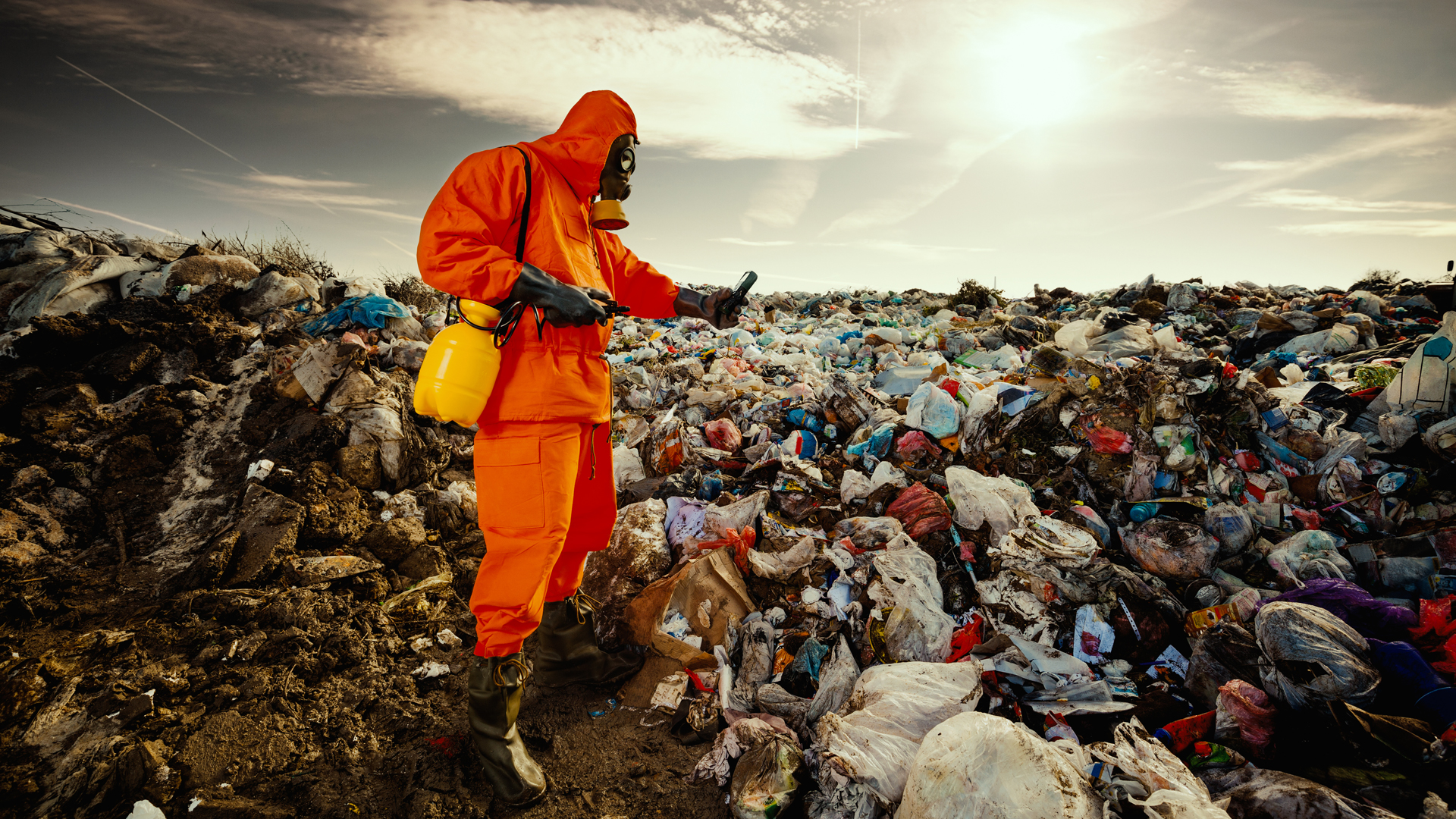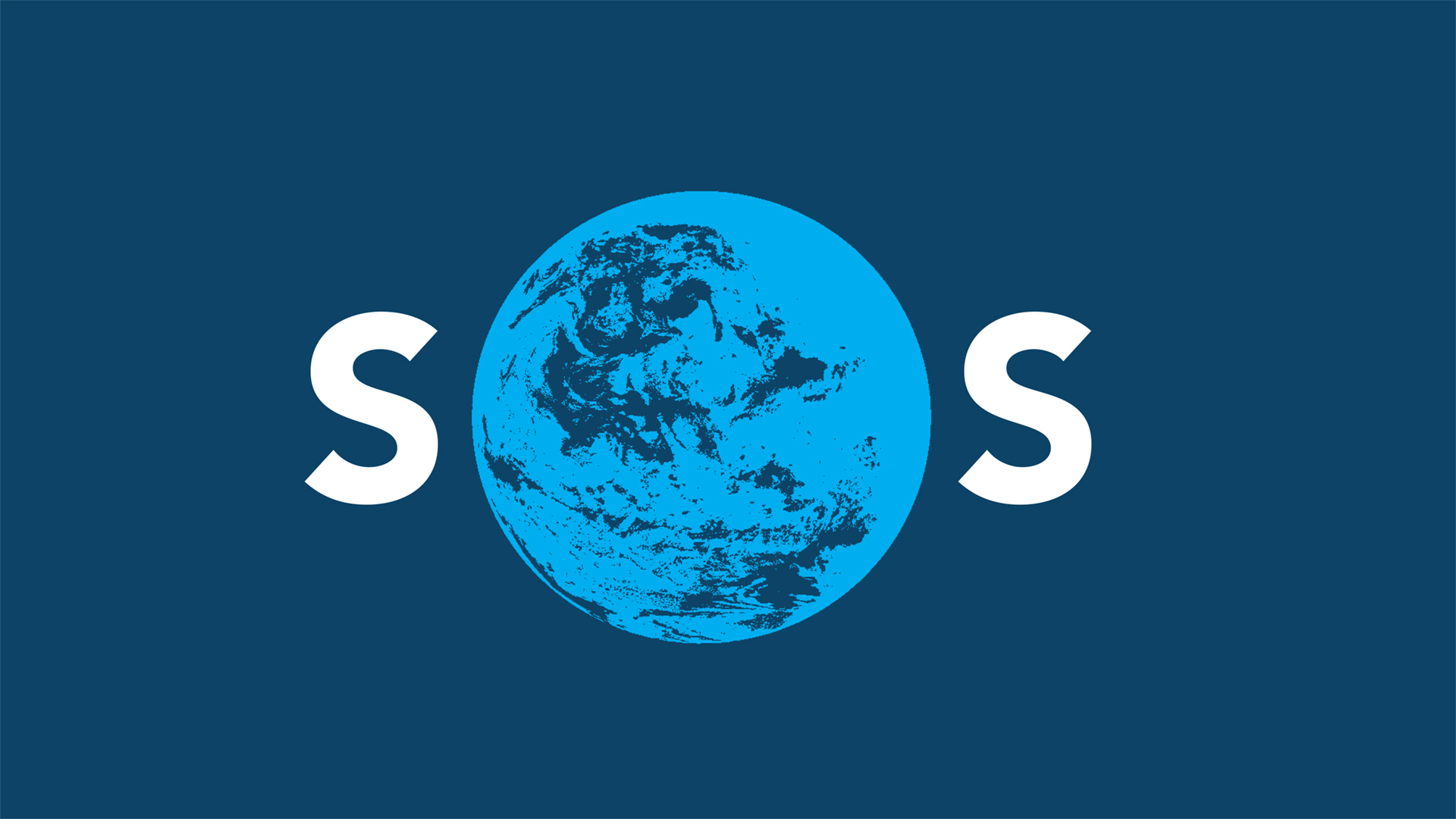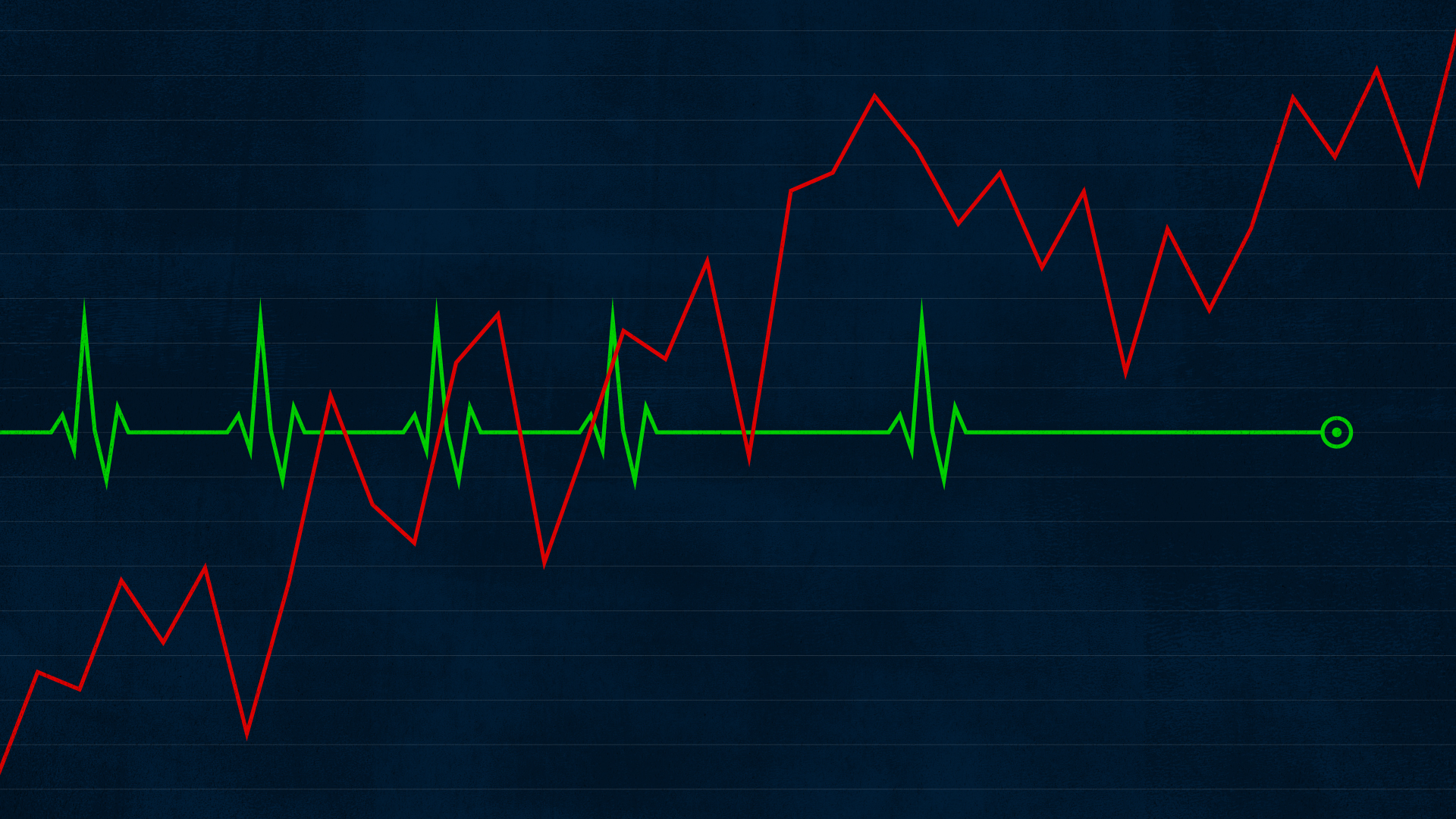Plastics: The Other Pandemic
Plastics are one of our most ingenious, useful and efficient chemical inventions. Unfortunately, they last virtually forever, slowly weathering into smaller and ever smaller fragments. What may be the consequences of this almost invisible plastic haze?
As the COVID-19 pandemic has shown us, it doesn’t take something large to create global havoc. Even the very small can bring disruption, ruin and death. And a virus is very small indeed. Coming in at only 100 nanometers (nm) or 0.0001 millimeters (mm)—it would take 500 virus particles to span the width of a single human hair. It’s amazing that such a tiny thing could render civilization almost powerless.
No doubt nature has many potential surprises still awaiting us. The natural world is a bubbling cauldron of biochemicals, and we’ve only added to the mix. Because species interactions with viruses and the coevolution of new strains occur constantly, novel strains and potential pandemics will remain a threat to the human population. And a growing population and capacity for human travel make global spread and infection even more likely in the future.
As people often say in times like these, hindsight is 20/20. We can’t wish away reality, but with the benefit of hindsight we can learn lessons and plan ahead.
And so, as we struggle through a viral day of reckoning and see the destruction that such a tiny particle of matter can wreak, it’s a good time to examine another all but invisible yet ever-present menace. The fragmented detritus of our plasticized world may be largely unseen, but our eyes are opening to its potential effect on our health and the health of the biosphere. These particles (microplastics, between 100 nm and 5 mm, and nanoplastics, smaller than a virus at <100 nm) surround us and permeate our very being.
How did they get there, and what are they doing?
The Synthetic Aesthetic
Look around. Just a few decades ago most of what we see didn’t exist, because the materials from which it’s composed weren’t yet invented. Wherever we are in the world, we’re surrounded by synthetic substances; plastics dominate.
Here’s an interesting little exercise: Wherever you are at the moment, look around. When you see something plastic, say “plastic” out loud. It will quickly become clear that we’re awash in a sea of it. Consider just a short list of hard plastics: the keys of a computer keyboard, a shirt button, a PVC pipe, a sheet of clear plexiglass, a kitchen utensil. Think about the crunchy crush of the ever-present disposable water bottle, the snap of a single-use fork, the plushiness of a stuffed animal, the reliable “burp” of a Tupperware lid, the immense versatility of polyester. It’s all plastic.
Due to their simple construction, plastics really are plastic. Created by chemically linking small molecular units known as monomers, the resulting chains, or polymers, can undergo endless permutations. These chains, cross-linked and combined with other chemicals, produce a substance that can be melted and manipulated into just about any form, color or texture.
The complexity derived from such simplicity is wondrous, ingenious. Natural polymers such as proteins and DNA also show variability, but nothing compares to what we have artificially cooked up. Whether fabrics, building materials, furniture, containers, wrappers, household gadgets or toys, we are embedded in the world of man-made materials. We live in the age of plastics. But it wasn’t always so.
“The ubiquitous presence of plastics in our lives makes them essentially unnoticed, unrecognized, and forgotten. And this is exactly why we all need to start thinking about them with more deliberate attention.”
It was in the postwar 1940s that plastics began to move from industry into the home and wider culture. Earl Tupper could be considered a key player in that transition. He had worked briefly at a DuPont plastics factory before the war and then started his own company. When DuPont asked him to find a use for the slag left over from refining petroleum, he invented one of the first chemical formulae for pliable plastic. His product was used widely in gas masks and other war matériel, but after the war Tupper hoped to find a profitable peacetime application. He filled his injection-molding system with his “Poly-T: Material of the Future,” and so Tupperware was born.
Tupper’s aim was not simply to repackage and move more petroleum waste but to create a product that would make life better. Up to this point, plastic products had been throwaway trinkets—combs, toys and “junk” of no lasting value. But Tupperware was different. “For advocates of modern design it epitomized the sculptural, machine aesthetic that defined plastic as a legitimate material within its own right,” writes design historian Alison J. Clarke. “Tupperware utilized plastic as a purposeful and tasteful aesthetic choice rather than a cheap and flippant gimmick.”
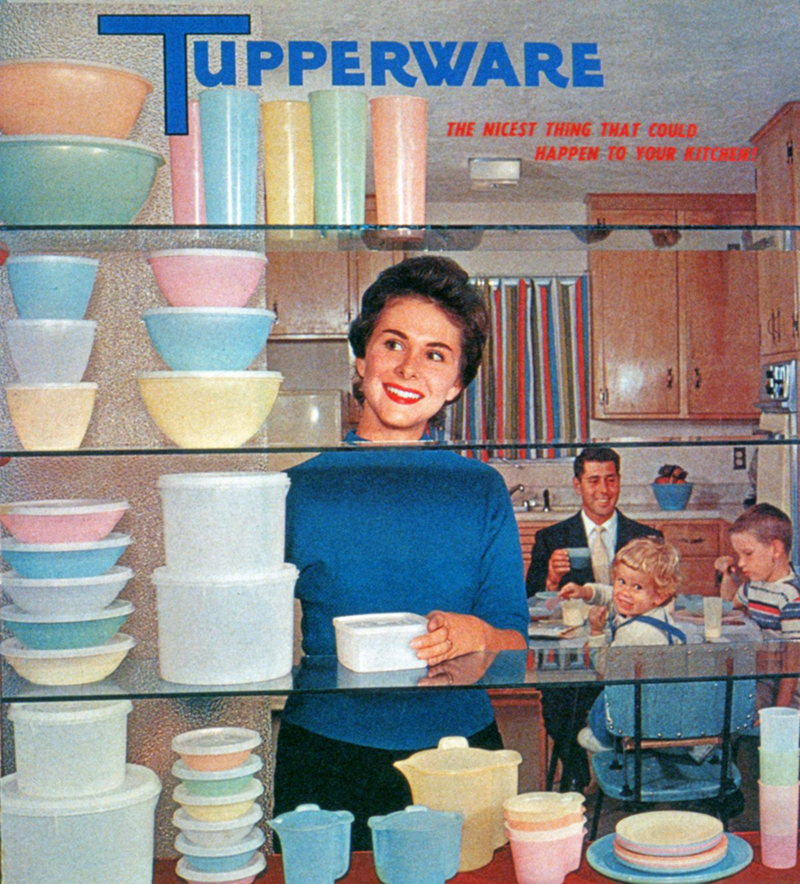
The 1958 Tupperware catalog promoted their product line as “the nicest thing that could happen to your kitchen!”
Embracing Plastic
It can be argued that Tupperware was the wedge that opened the door to widespread acceptance of plastic as an icon of modernity. Its inclusion in the Museum of Modern Art’s “Good Design” exhibition of 1944–1956 sealed Tupperware’s commercial fate, and the flow of plastic through that door hasn’t let up since.
Monsanto, another maker of wartime plastics, also sought to create new consumer markets. Professor of architecture Stephen Phillips describes vistas that lay waiting: “With plastics, a new world could be molded into the form of our desire. As the war ended, industry quickly shifted its attention to bring about this new synthetic world.”
Monsanto was thinking big: Why not invent a completely new kind of building and make—yes!—a whole house of plastic! “The Monsanto advertisement ‘From finger-tips to wing tips,’” Phillips notes, “maintained that just as man had used plastics during World War II in the ‘conquest of the air,’ so woman could now use plastics at home in the ‘conquest of man!’”
“Housework would become so easy that there would now be more luxury time to shop for glamorous synthetic outfits and cosmetics.”
Plastics were on the cusp of becoming a massively lucrative business. Phillips continues, “If Monsanto could cultivate desire for this new ‘plastic aesthetic’ along with the technical specifications to prove it was achievable, it might be able to ensure the long-term market success of its product.” To that end, Monsanto engineers worked with MIT to design the plastic house.
It was an extraordinarily creative feat. Phillips describes the vibe: “Wartime advancements in easy-to-install, mass-producible, unbreakable, lightweight, waterproof, continuously molded plastics were transmuted both conceptually and aesthetically into a new, modular, domestic spatial tectonic.” Finally constructed as a prototype in Disneyland’s 1957 Tomorrowland, the four-winged House of the Future hosted more than 20 million visitors over the next decade.
Its clean lines and acrylic brightness may have been impressive, but ultimately they were not compelling. Park officials opted to remove the house during a 1967 Tomorrowland upgrade, but when wrecking balls and other conventional methods failed to knock it down, workers had to use all manner of novel techniques, finally crushing and tying its modules into cabled-up bundles in order to truck them away, presumably to a Southern California landfill. It was a foreshadower of the persistence of plastic.

Monsanto’s prototype “House of the Future” was a popular Tomorrowland attraction in Disneyland from 1957 to 1967.
Nowhere to Go
The difficulty in demolishing the House of the Future illustrates the staying power of plastics. Synthetic polymers are built to last—by design and by nature. In terms of the latter, nature has no appetite for the synthetic. Plastic may be snapped, crunched and fragmented, but the smaller pieces are still the same plastic. There is no creature or fungus (with very limited exceptions) to consume them. Although newer formulations may exhibit some biodegradability, the vast sum (and it is vast) is virtually indestructible down to the last nanoparticle. So even when we might imagine it has gone away, like a dissolved virus on a disinfectant wipe, plastic remains invisibly present.
Unfortunately it’s these enticing characteristics—permanence and incorruptibility—that crown plastic as a sovereign ecological curse, “difficult or impossible for nature to assimilate,” note researchers Roland Geyer, Jenna Jambeck and Kara Law.
With nowhere to go, fragments accumulate everywhere, across the land and from the surface to the bottom of the sea. Huge gyres of plastic trash circulate in all of the earth’s oceans. Investor and explorer Victor Vescovo even found a plastic bag drifting at the bottom of the Mariana Trench, the deepest oceanic depression on the planet. Others have dredged up more extensive collections.
“The Mariana Trench has higher levels of overall pollution in certain regions than some of the most polluted rivers in China, according to a study in February 2017.”
Although scientists are not yet definitive about the final real-world outcomes, research is revealing clear trends. Plastics are not simply drifting through the environment; they’re being incorporated into the living world as well. “Microplastics have been detected in digestive tracts or tissues of a considerable number of field collected marine animals, including crustaceans, fish, bivalves, turtles, mammals, seabirds, and so on,” reads a 2019 report by researchers at China’s National Marine Environmental Monitoring Center. They add that by 2050 there may be a greater weight of plastic in the sea than fish.
But while we read and hear much about our plasticized seas, the land is not immune either. Like a fine sprinkling of powdered sugar, plastic dust settles in the most remote areas. “We approximate that more than 1000 tons of plastic from the atmosphere are delivered to western protected areas in the United States, including national parks and wilderness areas, each year,” say the authors of a 2020 research report published in Science. “This is equivalent to about 120 to 300 million plastic water bottles.” One wonders about the concentration within our own homes. How much of the dust under our beds is actually superfine plastic?
They also warn of the effect on wildlife. “As plastics accumulate in pristine wilderness, we may anticipate shifts in community composition, possibly leading to declines in biodiversity on the basis of the different tolerances to the physical and toxicological consequences of consuming microplastics.”
The authors suggest that “plastic emission sources have extended well beyond our population centers and, because of the longevity of plastics, have spiraled through the Earth system.”
But I Thought We Were Recycling
Even though many of us recycle, it isn’t commercially profitable. Chemists have figured out how to chop up certain polymers and reconfigure them once or at most twice, but no current methods have been brought to scale. To keep plastic waste from escaping into the environment, someone must be motivated to not only collect but process it.
But even when a bottle ends up in the recycling bin, it’s naive to think it will actually be recycled. For industrial manufacturing, it’s cheaper to simply make new plastic. The incentives to discard used plastics—supply and demand, lax international environmental laws, first-world consumer apathy under the sway of recycling mythology, easy access to third-world dumping grounds—have allowed and even encouraged makers to direct new petroleum extracts toward building more virgin product rather than recycling old.
Falling demand for oil, thanks in part to COVID-19 travel restrictions and growing calls to reduce CO2 emissions, has also encouraged a greater focus on alternative but equally profitable uses for petroleum. After all, the plastics people are often also the petroleum-generating companies, with Exxon Mobil and Chevron heading the US list. To remain profitable, these companies can’t actively try to cut back our dependence on fossil fuels; rather, they need to promote ways to keep the plastics pipeline flowing and find new markets for their products. At this point there is no motive for repentance—only for switching from gasoline to plastic.
“The oil industry makes more than $400 billion a year making plastic, and as demand for oil for cars and trucks declines, the industry is telling shareholders that future profits will increasingly come from plastic.”
And so the great mass of old plastic is just discarded. Most is in the form of single-use items such as packaging, plastic wrap and water bottles; a mind-numbing 580 billion disposable bottles are expected to be sold in 2021—more than 18,000 per second. An October 2020 report by Kara Lavender Law and colleagues in Science Advances shows that the United States generates the most waste plastic each year, a phenomenal 130 kg (287 lbs) per person. In contrast, China, with a population about four times larger, not only produces less waste overall but comes in under 16 kg per capita. The United Kingdom ranks second behind the United States at 88 kg per capita, while the combined figure for the European Union and the United Kingdom is about 55 kg per capita.
Law reports that in the United States, despite a robust plastic waste management infrastructure and public engagement, only about 9 percent of used plastic is in fact collected. Between 1 and 2-plus million metric tons of US plastic waste invades the environment as litter or illegal dumping, or is inadequately managed (often just leaked into the environment) by the countries that receive trash as an export from developed nations.
In their report “Production, Use, and Fate of All Plastics Ever Made,” Geyer and his colleagues note that while recycling rates are two to three times higher in both China and Europe than in the United States, the rates of incineration are also higher. The US burns 16 percent of its collected plastic waste (down from 21 percent in 1995), China 30 percent, and Europe 40 percent. Clearly only a small percentage of plastic waste is actually given a new life.
Remember that plastics were invented to churn distillation waste into a cash product. Earl Tupper may have had higher goals, but in a capitalist/industrial sense, this has been a booming 70-year run. It makes sense, if only in terms of manufacturing profitability, that used materials are more likely to be burned or dumped than recycled. While researchers predict that in the next 30 years less waste will be discarded because recycling will increase, the pace of incineration is expected to increase even faster.
Geyer estimates that, overall, more than 8,300 million metric tons (Mt) of virgin plastic have been produced since 1950, roughly the beginning of the plastics industry. If we do the math at 2,200 pounds per metric ton, that’s 18,260,000,000,000 pounds.
The concern is not simply over large numbers. Humans, by way of comparison, produce more than a billion pounds of babies each year. But eventually, as nature designed it, babies grow up and at some point in the future return to the earth, and the ingredients start afresh—unlike plastic, our man-made baby. Not only doesn’t plastic decompose and go away, but there’s always plenty more in the pipeline.
What is the unaccounted-for cost of this tremendous mass of man-made material that’s lost into the world (and the atmosphere) at large? What is its fate, and how is it tied to our own?
The Food-Web Boomerang
While some plastic begins small, such as the beads found in certain liquid scrubs and cleansers, most is born macro-sized, larger than 5 mm. Whether it starts out small or large, though, all plastic is destined for eventual miniaturization. But simply breaking it down into ever-smaller pieces doesn’t make it disappear. “The life cycle of micro(nano)plastics is long, regardless of their source,” note Miguel Oliveira and colleagues in a 2019 research article aptly titled “A Micro(nano)plastic Boomerang Tale: A Never Ending Story?”
“It is possible to verify that the majority of the man-made products that are present in our daily lives will, most definitely, find its way into the soil and water reserves,” Oliveira writes. “But unlike degradable substances that will suffer decomposition and re-enter the base-chain as nutrients, microplastics are not degraded, just weathered into smaller and smaller particles, until it is almost impossible to verify its existence.”
“Without a well-designed and tailor-made management strategy for end-of-life plastics, humans are conducting a singular uncontrolled experiment on a global scale.”
Determining just how much plastic humans consume is a tricky and ongoing challenge. Some researchers have suggested that each of us could be eating 5 grams a week, or a credit card’s worth.
Others take issue with such a specific amount. Authors of a 2019 study published in the American Chemical Society’s journal Environmental Science and Technology have also estimated the amount of plastic we ingest, but they stress that the true quantitative value is still unknown. Lead researcher Kieran Cox, a biologist at the University of Victoria in British Columbia, told Vision that their findings are “certainly a conservative underestimate. The real amount has a real mass and will be known in the near future. But not yet. These studies are really ramping up, but to equate it with a credit card is not actually accurate at this time.”
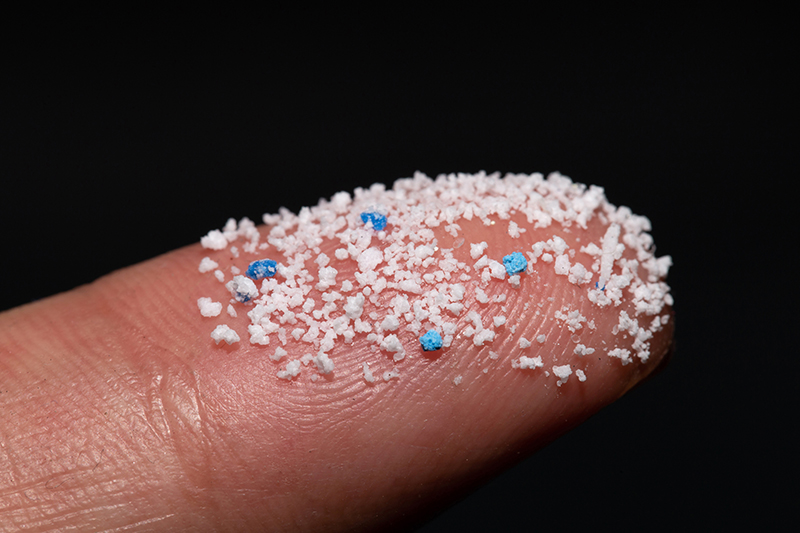
An accurate and scientifically validated number will be useful. But whether it confirms a credit card, a grain of rice or a slice of pie, it’s not only the plastic itself that matters. As researchers from the University of Toronto wrote recently, “plastics are a complex pollutant” that can have a wide range of negative effects. “This ‘chemical cocktail’ consists of the residual monomers that make up the plastic polymer, the additives that are added during manufacturing, and the contaminants that sorb from the surrounding environment.” They note that many of these chemicals are listed as “priority pollutants” by the US Environmental Protection Agency “because they are persistent, bioaccumulative, and/or toxic.”
So while the megatonnage of plastic detritus that circulates around the globe is by itself a persistent problem, even more concerning is the hazard posed by the chemical content it carries. There are the toxins we know, and those we do not; individual residues we recognize, and synergies that are a mystery. And we’re just beginning to realize that we’ve created an immense and virtually invisible delivery system propelling these toxins straight back at the entire living world, including us.
Just as a novel virus cobbled from old sources is termed an emerging disease, so the microplastic-toxin hybrid is a kind of novel “emerging contaminant.” And we are surrounded.
Researchers in the Netherlands have described how immersed we are in this soup of contamination: “Humans are exposed to micro- and nanoplastics via consumption of contaminated (marine) animals and other food and consumer products such as toothpaste, beer, honey, salt and sugar. Additional human oral exposure results from drinking water and from mineral water bottled in plastics and cartons. Additional inhalation exposure results from micro- and nanoplastics released from textiles, synthetic rubber tires and plastic covers.”
Perhaps more troubling still is a just-released study from Italy, which reports that the presence of microplastics has now been confirmed in human placentas. The authors conclude that “due to the crucial role of placenta in supporting the foetus development and in acting as an interface between the [unborn baby] and the external environment, the presence of exogenous and potentially harmful (plastic) particles is a matter of great concern.” The fact that these materials were found on both the mother’s side and the baby’s side of the placenta is evidence that even the unborn are now exposed to circulating plastic and its chemical payload.
The Narrow Path
As environmentalist Rachel Carson warned decades ago when synthetics began to be widely released into the environment (her particular concern at the time was the pesticide DDT), there’s no way to know what the consequences will be when we add our own creations to the natural world. Have we planted a minefield and walked into it?
Our plastics dilemma makes a viral pandemic seem almost tame. At least with a viral particle we can aim toward eventual immunity. But just as we’re learning of COVID-19’s capacity to inflict neurological damage (along with its more immediate attack on respiratory and circulatory functions) with potentially long-range effects, we’re also coming to realize the deeper implications of our plastic miasma. The problem is much more profound than the ugliness of litter, or sea life impaled on plastic straws.
These are not things we expected. Earl Tupper would not have predicted it.
In a journal entry in the late 1930s, Tupper wrote under the heading “My Purpose in Life” a vision that many of us would probably share. He wasn’t interested solely in making a profit. He wanted to do something that would improve the human condition, not degrade it. Tupper’s dream was to “try to understand the true purpose and intent of everything that has interest or usefulness to humanity and posterity.” Tupperware was his bid for making life better.
If properly cared for, plastics are of great value to humanity. Sterile and lightweight packaging, for example, is highly beneficial. When used with reasonable purpose and intent, including a plan for dealing with the used materials after their primary job is done, plastics can literally be lifesavers. But as it stands, our lack of stewardship over the plastic world we’ve collectively created will haunt us for a long time to come. Going back to Tupper’s words, we didn’t think much beyond “usefulness.” We lost any sense of posterity and of what happens next.
It did not need to be this way. A different set of principles could have steered us down a more benign path that would profit all of us for generations to come rather than one that mostly profits corporations right now. In a sense, we chose the wide path rather than the narrow. That second, more thoughtful and maybe selfless way seems more in accord with Tupper’s goal—to see beyond the self and the present, and to think forward and outward, always considering the future and the best interests of those to come.

